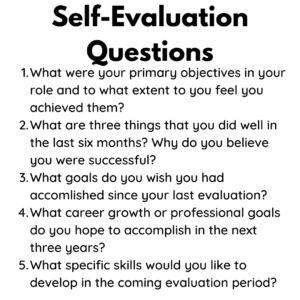Part 3: Evaluation, Feedback, and Reflection
By the end of this chapter you should be able to:
- Evaluate personal accomplishments and experiences related to master’s program of study. (LO4)
- Analyze how to achieve professional growth in industry. (LO5)
- Reflect on feedback provided by supervisor. (LO6)
Purpose of Evaluations
Performance appraisals are one of the most important components of any job, because they recognize where employees are strong and offer suggestions for improvement. There are a few reasons for workplace evaluations and performance feedback:
- Feedback to employees
- Performance appraisals provide feedback to employees about quantity and quality of job performance. Without this information, employees have little knowledge of how well they are doing their jobs and how they might improve their work.
- Self-development
- Performance appraisals can also serve as an aid to employee self-development. Individuals learn about their strengths and weaknesses as seen by others and can initiate self-improvement program.
- Reward systems
- In addition, appraisals may form the bases of organizational reward systems—particularly merit-based compensation plans.
- Personnel decisions
- Performance appraisals serve personnel-related functions as well. In making personnel decisions, such as those relating to promotions, transfers, and terminations, they can be quite useful. Employers can make choices on the basis of information about individual talents and shortcomings. In addition, appraisal systems help management evaluate the effectiveness of its selection and placement functions. If newly hired employees generally perform poorly, managers should consider whether the right kind of people are being hired in the first place.
- Training and development
- Finally, appraisals can help managers identify areas in which employees lack critical skills for either immediate or future performance. In these situations, new or revised training programs can be established to further develop the company’s human resources.
Sample Evaluation: Completed by Supervisor
Below is a sample evaluation that a supervisor would fill out for an employee. Review the details and reflect on potential responses that a current supervisor may have about you.
Sample Evaluation: Completed by Employee
After reviewing the workplace evaluation, review the potential self-evaluation questions that an organization may ask you to answer.

Feedback Assessment
As a result of an evaluation, your supervisor will probably provide feedback, to help you progress as an employee. Feedback, especially if it is negative, can be very hard to accept. Complete the following assessment to determine how you typically receive feedback. To complete assessment select, Start the Course. You can review the types of feedback styles prior to beginning the assessment.
Reflection
Reflection is an opportunity for you as the learner and the employee to take a moment to analyze your progress as a professional. There are a few terms to consider when reflecting, that may guide you as you engage in this process.
- Recalling: Recall specific episodes or events that provide evidence that you have grown as a learner and employee. Also recall, though it may be difficult, those instances where you could improve your behavior.
- Recapturing: Capture the emotions, accomplishments, and challenges that you’ve experienced during the span of this course.
- Relating: Connect those recollections with other experiences that you’ve had in the past. Have you progressed? And you regressed? What steps can you take to future improve.
- Rationalizing: Evaluate the patterns or learning experiences to create meaning from the past events.
- Redirecting: Engage in purposeful thinking directed toward future actions and goals.
The image below can help you visualize the process of deeper reflection.

Conclusion:
Throughout this course, you have learned how to create SMART goals, which can help you academically and professionally. You can recall the proper etiquette for professional interviews; these are skills that can be generalized to a wide range of uses. And finally, you have reflected on your personal accomplishments and experiences, while also creating a plan for professional growth. As you move beyond this course, here are some last tips for taking the goals, feedback, and evaluations into the future:
- Focus on your long-term career plan, but recognized that everyone will have a different (potentially ever-changing) journey to that ultimate goal. Practice patience with yourself and others.
- Maintain an ongoing dialogue with your supervisor, your mentor, and anyone else who has a role in your professional growth. Communicate your goals and aspirations clearly.
- Remain positive as much as possible. Develop a plan for professional improvement, but minimize negative-self talk should your timeline be delayed by factors outside your control.
- Finally, reflect on feedback and evaluations, considering them a tool to propel you to greater positions.
References for Remixed Content:
go3HR (n.d.) Human resources in the food service and hospitality industry. Pressbooks. Retrieved February 18, 2022 from https://ecampusontario.pressbooks.pub/hrinfoodservices/back-matter/appendix-7-sample-performance-evaluation-form/
Huang, L. (2017). Three ideas for implementing learner reflection. Faculty Focus. https://www.facultyfocus.com/articles/teaching-and-learning/three-ideas-implementing-learner-reflection/
OpenStax (n.d.). Organizational Behavior. OpenStax. Retrieved February 18, 2022 from http://Finally, appraisals can help managers identify areas in which employees lack critical skills for either immediate or future performance. In these situations, new or revised training programs can be established to further develop the company’s human resources.

